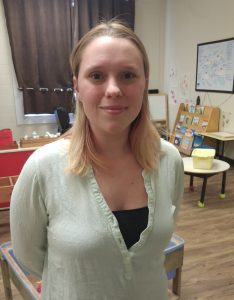A teacher in a preschool classroom in the U.S. was
surprised and encouraged by her young students. Food is
eaten at the preschool at a set time with everyone,
including the teacher, sitting down to eat. When the
teacher related her allergies to the students, they
responded with curiousity and support. They had a lot of
questions and then provided support and awareness of
the importance of keeping the allergic food away from
her!
Great story to share with many groups to raise
awareness and encourage support for the allergy
population. Later on, a new student also had a food
allergy, bringing even more awareness to the preschool
group of student!

- H
- ALLERGIC LIVING
In My Preschool Class, the Kids Have Become My Food Allergy Protectors
A preschool having a teacher with food allergies turned into a rewarding experience for all, with interested and proactive responses from the young preschool students. The story is one of understanding from the students when eating at the preschool and being mindful of the allergy and reaction to exposure.
By: Susanna Lyons in Managing Allergies, Your StoriesPublished: April 30, 2019

Susanna Lyons
A career involving education and children is just as rewarding and challenging as I imagined it would be. But adding my own need to manage food allergies to the equation has proved more eye-opening than expected.
At the preschool where I work as an early childhood educator, I will sit down for lunch at a table with my group of eight students, who range in age from 3 to 5 years old. Lunch is served “family style,” which means the educator is meant to eat with the kids, joining the conversation and acting as a role model for table manners.
However, being allergic to tree nuts, peanuts, soy, beans, chickpeas and lentils means I can’t always eat the food the children are being served, since legumes are a big ingredient on the menu of our childcare center.
“If You Eat Candy, Will You Get
Sick?” One Preschooler Asked
When I first started, I was concerned that by not eating with the children, I would be setting a bad example and that they wouldn’t understand I wasn’t doing this by choice.
Boy was I wrong. When I first told my group about my allergies, I was met with confusion, but also compassion that I didn’t anticipate from children so young. The children were concerned that I would get sick, so we spent 20 minutes going over my allergies and spoke about the differences between not liking a food and having to avoid it because of food allergies.
This conversation changed our lunch routine. We’d still eat together, but the children would ask questions about my allergies and remind me to stay safe. They’d say things like:
“Susie can’t eat beans, but she can eat corn.”
“Susie, if you eat candy will you get sick? Because I like candy and when I eat it I don’t get sick.”
“Susie, remember, if you eat peanuts, you have to go to the hospital. So don’t eat them, OK?”
One Child Went Over My Allergies
with Her Whole Family
The concept of food allergies is a hard one for children to grasp and the constant repetition of these conversations is their way of making sense of it. The kids in my preschool group not only talk to me daily about my food allergies, but also inform new children that start in our classroom about them, along with staff and their own parents. Once a parent even told me her daughter would go over all of my allergies at the dinner table, every night, with the whole family!
Of course, I’m not the only one at the preschool with food allergies, and I have had children in my class with food allergies that are in opposition to mine. For instance, one child had a severe dairy allergy, and I was highly allergic to her substitution – soy milk beverage.
We found a workaround: the other teacher in the class had the dairy-allergic girl sit with her lunch group and, when I did have to handle this student’s food, I made sure to wear gloves so I didn’t touch any soy-based foods.
Finding Workaround for
Conflicting Allergies
I eventually let the student pour her own soy milk. If she happened to spill it, a child would run, without being asked, to clean it up because they wanted to make sure I was safe.
Despite sometimes conflicting allergies, it’s easy for me to relate to students who come into the classroom with food allergies, and who may feel out of place because their lunch is different from lunch served to other students.
I had struggled with whether to tell the students about my food allergies because I thought this might be too confusing for them. But explaining the condition at this young age clearly has had advantages. They now have a better understanding of what the condition involves, and have developed compassion for those who live with food allergies.
With the opposing allergies, it also leads to many conversations with the students about differences among people. It has opened windows to conversations about those with medical and physical needs that are different from their own. It has taught these kids something that can’t be learned through a textbook: empathy and kindness for others who may seem “different.”
Susanna Lyons is an Early Childhood Educator based in Dartmouth, Nova Scotia.




Leave A Comment